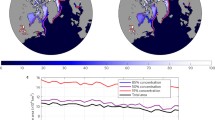Abstract.
To understand the influence of the Bering Strait on the World Ocean’s circulation, a model sensitivity analysis is conducted. The numerical experiments are carried out with a global, coupled ice–ocean model. The water transport through the Bering Strait is parametrized according to the geostrophic control theory. The model is driven by surface fluxes derived from bulk formulae assuming a prescribed atmospheric seasonal cycle. In addition, a weak restoring to observed surface salinities is applied to compensate for the global imbalance of the imposed surface freshwater fluxes. The freshwater flux from the North Pacific to the North Atlantic associated with the Bering Strait throughflow seems to be an important element in the freshwater budget of the Greenland and Norwegian seas and of the Atlantic. This flux induces a freshening of the North Atlantic surface waters, which reduces the convective activity and leads to a noticeable (6%) weakening of the thermohaline conveyor belt. It is argued that the contrasting results obtained by Reason and Power are due to the type of surface boundary conditions they used.
Similar content being viewed by others
Author information
Authors and Affiliations
Additional information
Received: 27 October 1995/Accepted: 20 November 1996
Rights and permissions
About this article
Cite this article
Goosse, H., Campin, J., Fichefet, T. et al. Sensitivity of a global ice–ocean model to the Bering Strait throughflow. Climate Dynamics 13, 349–358 (1997). https://doi.org/10.1007/s003820050170
Issue Date:
DOI: https://doi.org/10.1007/s003820050170




